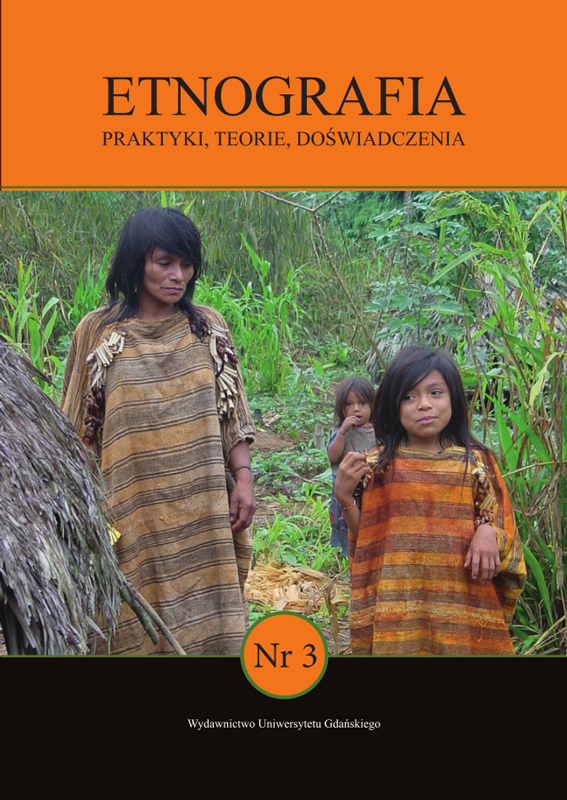Diabeł w sutannie, czyli ontologia pewnych bytów według Indian Matsigenka z peruwiańskiej Amazonii
DOI:
https://doi.org/10.4467/254395379EPT.17.005.9241Słowa kluczowe:
Matsigenka, Amazon, Peru, religious missions, indigenous cosmologiesAbstrakt
The Matsigenka Indians from the Peruvian Amazon believe in the existence of demoniac beings called kamagarini. These demons use to rape people anally, in this manner transforming them (or their spiritual essences – isure) into creatures of the same kind as the rapist. Catholic and protestant missionaries usually identify kamagarini with Western concept of devil. Surprisingly it seems that [at least some] Matsigenka perceive the catholic missionaries as, in important aspects, similar to the kamagarini demons.
Downloads
Bibliografia
Baer, G. (1994). Cosmología y shamanismo de los matsiguenga (Perú Oriental). Quito: Ediciones Abya Yala.
Bennett, B.Y. (1991). Illness and Order: Cultural Transformation among the Machiguenga and Huachipairi, praca doktorska. New York: Cornell University.
Calavia Sáez, O. (2001). El rastro de los pecaríes: Variaciones míticas, variaciones cosmológicas e identidades étnicas en la etnología pano. Journal de la Société des Américanistes, 87, 161–176.
Collins, J. (1952). The Mythological Basis for Attitudes toward Animals among Salish--Speaking Indians. The Journal of American Folklore, 258(65), 353–359.
Davis, P. (2002). Los machiguengas aprenden a leer: Breve historia de la educación bilingüe y el desarrollo comunal entre los machiguengas del Bajo Urubamba. Lima: Pontificia Universidad Católica del Perú & Instituto Lingüistico de Verano.
Descola, P. (1992). Societies of Nature and the Nature of Society. W: A. Kuper (ed.), Conceptualizing Society (s. 107–126). London: Routledge.
Descola, P. (1997). The Spears of Twilight: Life and Death in the Amazon Jungle. London: Flamingo.
Deyermenjian, G. (1988). Land Rights, Cultural Survival and Innovation Among Indigenous Peoples of the Western Amazon Basin: The Case of the Machiguenga, praca magisterska. Worcester: Clark University.
Endleman, R. (1986). Homosexuality in Tribal Societies. Transcultural Psychiatry, 23, 187–218.
Fausto, C. (1999). Of Enemies and Pets: Warfare and Shamanism in Amazonia. American Ethnologist, 26(4), 933–956.
Fausto, C. (2007). Feasting on People: Eating Animals and Humans in Amazonia. Current Anthropology, 48(4), 497–530.
Gow, P. (2001). An Amazonian Myth and Its History. Oxford: Oxford University Press.
Johnson, A. (2003). Families of the Forest: The Matsigenka Indians of the Peruvian Amazon. Berkeley–Los Angeles–London: University of California Press.
Lenaerts, M. (2006). Substances, Relationships and the Omnipresence of the Body: An Overview of Ashéninka Ethnomedicine (Western Amazonia). Journal of Ethnobiology and Ethnomedicine, 2(49), 1–19.
Mason, P. (2000). Pretty Vacant: Columbus, Conviviality and New World Faces. W: J. Overing, A. Passes (eds.), The Anthropology of Love and Anger: The Aesthetics of Conviviality in Native Amazonia (s. 189–205). London–New York: Routledge.
Opas, M. (2005). Mutually Exclusive Relationships: Corporeality and Differentiation of Persons in Yine (Piro) Social Cosmos. Tipití. Journal of the Society for the Antropology of Lowland South America, 3(2), 111–130.
Rosengren, D. (1987). In the Eyes of the Beholder: Leadership and the Social Construction of Power and Dominance among the Matsigenka of the Peruvian Amazon. Göteborg: Göteborgs Etnografiska Museum.
Rosengren, D. (2004). Los matsigenka. W: F. Santos Granero, F. Barclay (eds.), Guía Etnográfica de la Alta Amazonía. T. 4 (s. 1–157). Panamá–Lima: Smithsonian Tropical Research Institute & Instituto Francés de Estudios Andinos.
Rosengren, D. (2006). Matsigenka Corporeality, a Nonbiological Reality: On Notions of Consciousness and the Constitution of Identity. Tipití. Journal of the Society for the Antropology of Lowland South America, 4(1–2), 81–102.
Shepard, G.H. (1999). Pharmacognosy and the Senses in Two Amazonian Societies, praca doktorska. Berkeley: University of California.
Snell, B.A. (2011). Diccionario matsigenka-castellano con índice castellano, notas enciclopédicas y apuntes gramaticales. Lima: Instituto Lingüístico de Verano.
Taylor, A.C. (1992). Remembering to Forget: Identity, Mourning and Memory among the Jívaro. Man, 28(4), 653–678.
Tessmann, G. (1999 [1930]). Los indígenas del Perú nororiental. Investigaciones fundamentales para un estudio sistemático de la cultura. Quito: Ediciones Abya Yala.
Viveiros de Castro, E. (1992). From the Enemy’s Point of View: Humanity and Divinity in an Amazonian Society. Chicago–London: The University of Chicago Press.
Viveiros de Castro, E. (1998). Cosmological Deixis and Amerindian Perspectivism. Journal of the Royal Anthropological Institute, 4(3), 469–488.
Viveiros de Castro, E. (2001). GUT Feelings about Amazonia: Potential Affinity and the Costruction of Sociality. W: L.M. Rival, N.L. Whitehead (eds.), Beyond the Visible and the Material: The Amerindianization of Society in the Work of Peter Rivière (s. 19–43). Oxford: Oxford University Press.
Viveiros de Castro, E. (2002). Imanência do inimigo. W: E. Viveiros de Castro (ed.), A Inconstância da alma selvagem. São Paulo: Cosac Naify.
Werner, D. (1998). On the Evolution and Cross-Cultural Variation in Male Homosexuality, www.gay-art-history.org/gay-literature/gay-studies/evolution-homosexuality/male-homosexuality-biological.html [dostęp: 2008].
Whitehead, H. (1989). The Bow and the Burden Strap: A New Look at Institutionalized Homosexuality in Native North America. W: S.B. Ortner, H. Whitehead (eds.), Sexual Meanings: The Cultural Construction of Gender and Sexuality (s. 80–115). Cambridge–Port Chester–Melbourne–Sydney: Cambridge University Press.
Pobrania
Opublikowane
Jak cytować
Numer
Dział
Licencja
Czasopismo wydawane jest na licencji Creative Commons Uznanie autorstwa-Na tych samych warunkach 4.0 Międzynarodowe.

 Uniwersyteckie Czasopisma Naukowe
Uniwersyteckie Czasopisma Naukowe








